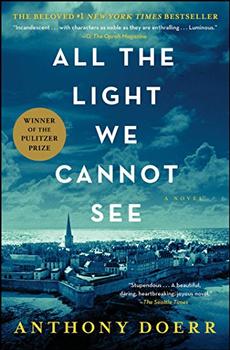Summary | Excerpt | Reading Guide | Reviews | Beyond the book | Read-Alikes | Genres & Themes | Author Bio

Critics' Opinion:
Readers' Opinion:
First Published:
May 2014, 448 pages
Paperback:
Apr 2017, 544 pages
 Book Reviewed by:
Book Reviewed by:
Naomi Benaron
Buy This Book
Voted 2014 Best Fiction by BookBrowse's Members
(and the book you've rated the highest out of the last two years!)
Every once in a while you find that rare jewel of a book that leaves you breathless, at once wanting to begin again as soon as the last word is devoured, and unable to do so because of the great and important weight of the story. Anthony Doerr's All the Light We Cannot See is such a book. Sensually rich, gorgeously wrought, with characters that come alive on the page, and driven by a story that takes hold and does not let go, this tale shines a light on the small and often overlooked corners of war. Although set in World War II, the book's scope and breadth are far greater. It is a novel of humanity, and the questions we face in trying to preserve what makes us human in a world of unspeakable inhumanity; it is a novel of intrigue and suspense, the noose of the pursuit tightening as the end approaches; it is a love affair with the written word and a testament to the power of books to save us.
The story opens on 7 August 1944: "Zero." Marie-Laure LeBlanc, a blind sixteen-year-old French girl is alone in her uncle Etienne's home, waiting for him to return. Because she is sightless, she cannot read the leaflet she discovers stuck in her window shutter, a warning dropped by the Americans urging all civilians to flee. At the same time, Werner Pfennig, "a white-haired eighteen-year-old German private" is barracked inside L'Hôtel des Abeilles - the Hotel of Bees - five streets north of Marie-Laure. In a matter of moments, the siege of Saint Malo, "the brightest jewel of the Emerald Coast of Brittany, France," will begin, and the Americans will drop enough incendiary ordinance on the town to burn it nearly to the ground. [See Beyond the Book.] From here the novel alternates between the backstories of Marie-Laure and Werner, beginning in 1934, and their lives during the bombardment.
By using the present tense, Doerr imparts immediacy and urgency to the writing. The story's past and its present equally engage the reader as Werner and Marie-Laure's histories veer toward their inevitable collision with the day of the siege and with each other. Doerr handles this complexity of structure seamlessly; the reader is never confused or jarred by transitions but rather slips easily and willingly between timelines.
In 1934, Marie-Laure, "is a tall and freckled six-year-old in Paris with rapidly deteriorating eyesight." She lives with her father, chief locksmith for the Paris Museum of Natural History. In the beginning, her blindness feels like a curse. But her father refuses to let her become dependent. He builds her an intricate model of her neighborhood that she learns by feel and takes her on guided walks where she learns to navigate by counting steps and by smell, texture, and sound. Thus she comes to understand that sightlessness can be a key to unlock deeper worlds:
To shut your eyes is to guess nothing of blindness. Beneath your world of skies and faces and buildings exists a rawer and older world, a place where surface planes disintegrate and sounds ribbon in shoals through the air. Marie-Laure can sit in an attic high above the street and hear lilies rustling in marshes two miles away.
Marie-Laure's other passions include the museum's mollusk collections and Braille editions of Jules Verne's novels. These worlds provide enlightenment and escape. Ultimately, they will be her salvation.
In 1934, Werner Pfennig is in an orphanage in Zollverein with his beloved sister Jutta. In normal times, their paths would never cross; Marie-Laure would live in the world of museums and academics, and Werner would be destined to toil in the mines that killed his father. His brilliance in mathematics, physics and electronics would remain untapped. But in 1939, with war engulfing Europe, the Nazis provide a way out when Werner fixes a radio belonging to the wife of a lance corporal. He is then sent to a school for Hitler Youth's elite that is, as Doerr said in an interview with Marilyn Dahl, "Lord of the Flies mixed with Goethe, science and phrenology." From there, he embarks across Europe, searching for enemy radio transmissions by triangulation, on a path that will lead him to Saint Malo, the town to which Marie-Laure and her father flee when the Nazis occupy Paris in June 1940.
The thread that knots the storylines together is a diamond known as the Sea of Flames. "Grayish-blue with a red hue at its center. Recorded at one hundred and thirty-three carats. Either lost or willed to the king of France in 1738 on the condition that it be locked away for two hundred years." This is the MacGuffin, and it carries with it a mythological curse that pulls Marie-Laure and her father inside its deadly sphere of influence. The man who pursues the diamond is Sergeant Major Reinhold von Rumpel, a man of infinite patience and cold-hearted determination whose job is to evaluate the treasures stolen from vanquished lands. He is as close as Doerr gets to a villain; his presence stalks the pages of the novel like a cold wind.
It took ten years to write this book. Meticulously researched, Doerr recreates the most intimate details of his characters' worlds. The novel stands as a crash course in physics and math, radio communications, birds, the physiology and psychology of blindness, the anatomy of mollusks, and the education of Hitler Youth's elite. Despite these excursions, the writing never seems forced, self-conscious, or pedantic. Rather, the knowledge is integrated into scenes, as necessary and natural as the description of a lock of hair, an article of clothing. With devastating prose, All the Light We Cannot See explores the human consequences of war and the lethal choices we must make when held in its grip.
It is all unraveling, Werner can feel it; the fabric of war tearing apart… It strikes Werner just then as wondrously futile to build splendid buildings, to make music, to sing songs, to print huge books full of colorful birds in the face of the seismic, engulfing indifference of the world… Why bother to make music when the silence and wind are so much larger? Why light lamps when the darkness will inevitably snuff them? When Russian prisoners are chained by threes and fours to fences while German privates tuck live grenades in their pockets and run?
It is significant that the story takes place in Saint Malo, a town destroyed not by the Germans but by the Americans and more than likely unnecessarily. Doerr's world does not lend itself to the simplicity of heroes and villains.
Because you love these characters, you will hope for a measure of fairytale in the ending, but you will understand that in the world of this novel, no such ending is possible. And yet, Doerr gives us light. From the roughest stones of human weakness and tragedy, he fashions with this work a brilliant and glistening stone: a blue diamond.
Photos of Saint Malo then and now depict the precise rebuilding of the city.
Also, a video of the siege below:
![]() This review was originally published in The BookBrowse Review in May 2014, and has been updated for the
December 2014 edition.
Click here to go to this issue.
This review was originally published in The BookBrowse Review in May 2014, and has been updated for the
December 2014 edition.
Click here to go to this issue.

If you liked All the Light We Cannot See, try these:

by Elana K. Arnold
Published 2024
From Michael L. Printz honoree & National Book Award finalist Elana K. Arnold comes the harrowing story of a young girl's struggle to survive the Holocaust in Romania.

by Jennifer Rosner
Published 2024
From Jennifer Rosner, National Jewish Book Award Finalist and author of The Yellow Bird Sings, comes a novel based on the true stories of children stolen in the wake of World War II.





The House on Biscayne Bay
by Chanel Cleeton
As death stalks a gothic mansion in Miami, the lives of two women intertwine as the past and present collide.

The Flower Sisters
by Michelle Collins Anderson
From the new Fannie Flagg of the Ozarks, a richly-woven story of family, forgiveness, and reinvention.

The Funeral Cryer by Wenyan Lu
Debut novelist Wenyan Lu brings us this witty yet profound story about one woman's midlife reawakening in contemporary rural China.
Your guide toexceptional books
BookBrowse seeks out and recommends the best in contemporary fiction and nonfiction—books that not only engage and entertain but also deepen our understanding of ourselves and the world around us.